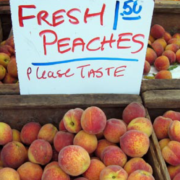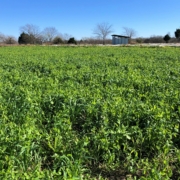Battling Borers in Organic Apple Production
 Print This Post
Print This Post
By Guy Ames, NCAT Horticulturist
Organic apple production in the Southeast U.S. has many challenges and controlling trunk borers is one of the most serious. Left unchallenged, borers can kill young apple trees before they ever get started bearing fruit. And older trees are not immune from the ravages of these pests either.
In the eastern half of the U.S. the larvae of two different species of beetles plague organic apple growers. (Though peaches have their own borer problems, other fruit trees are rarely bothered by borers.) Because regular pesticide sprays tend to control these critters, conventional growers may not even know these pests exist. Both species—the roundhead apple tree borer (Saperda candida) and the flathead apple tree borer (Chrysobothris femorata)—are endemic to eastern forests, having many wild hosts in addition to the domestic apple. Orchards close to woodland are especially prone to invasion from these beetles.
There are some slight behavioral differences between these two species. The flathead adult is earlier to emerge from the woods (April-May) and usually looks for places to lay her eggs a little higher on the trunk than the roundhead, which emerges a little later and usually prefers layer her eggs near the ground. The roundhead may also linger in the apple trunk for two years, while the flathead will complete its life cycle in one. Both can emerge from the woods and oviposit (lay eggs) in apple trees as late as September. By the way, unless you’re a keen observer, you are unlikely to ever see the adults. Look for pictures online if you’re curious. I find the roundheaded adult to be attractive with alternating tan and cream longitudinal stripes. Anyway…
Despite the few differences, for the practical purposes of the orchardist, these two species can safely be lumped together as one pest. Both enter the orchard, flying low, and looking for silhouettes of tree trunks. A beetle will land on a trunk and move downward looking for wounds or other anomalies in the bark. The roundhead usually ends up near the soil surface, the flathead a little higher up. Both species will often find the graft union area attractive for laying their eggs. When an egg hatches, the tiny larva will gnaw its way into the tree trunk and begin randomly tunneling throughout the cambium. Over time, the tunneling can effectively girdle a young tree. Older trees can tolerate some tunneling but still be stressed.
So, what to do? The first line of defense is maintaining tree health, especially providing adequate water. A tree in good health and growing vigorously can literally drown or cast out a young borer before it really gets started. But this is an imperfect, though important, management technique.
A surer control is to wrap the trunks with window screen from the ground to about 18” high. The top should be tied off snug with twine or something biodegradable and the bottom needs to be tight against the ground (throwing a little soil around the bottom can help). We don’t want to girdle the tree so wire is not a good tying material and even the twine can be too tight, so use some common sense here or plan to come back later and loosen the twine.
Even wrapping with screens is only about 95%, so it’s still a good idea to inspect your apple tree trunks for borers once or twice during the growing season and look for the tell-tale little pellets of orange-red sawdust at the base of the tree.
From “the do-as-I-say, not-as-I-do” category come the following photos (I failed to screen the trunks of a few young trees early last spring). All photos: Guy Ames, NCAT.
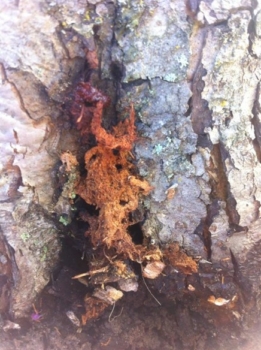
Borer frass at tree base. A sign that something is going on in there!

Getting ready for dubious battle with the borers. I’ve got on reading glasses and a little tool box containing my instruments of extraction.
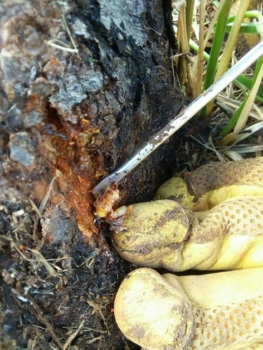
There it is! You can see the brown head on the upside. Gee, too bad I pulled it in half getting it out.

I started digging with a narrow-faced, slot-head screw driver, feeling for places where the bark felt spongy. Also on hand, I had some wire (about paper clip gauge), and other sharp carving tools. I don’t want to do more damage than the borer!
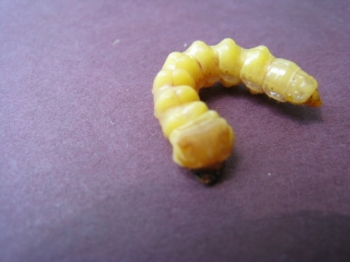
Here’s one I got out intact a few years ago.
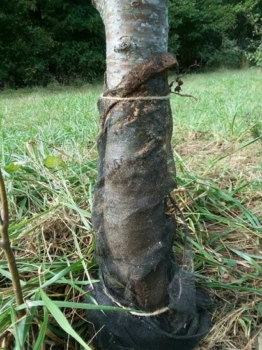
Properly wrapped tree.
Related ATTRA Resources:
Apples: Organic Production Guide
ATTRA Identification Sheet: Apple Insects
ATTRA Identification Sheet: Apple Diseases
This blog is produced by the National Center for Appropriate Technology through the ATTRA Sustainable Agriculture program, under a cooperative agreement with USDA Rural Development. ATTRA.NCAT.ORG.

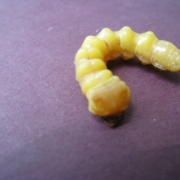
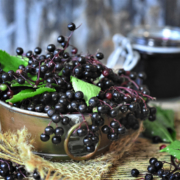
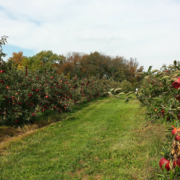
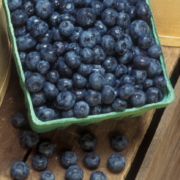
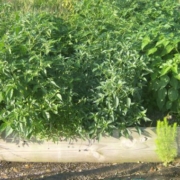
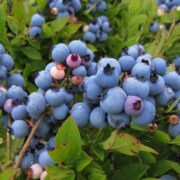 Wikimedia
Wikimedia